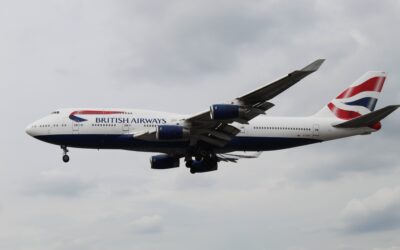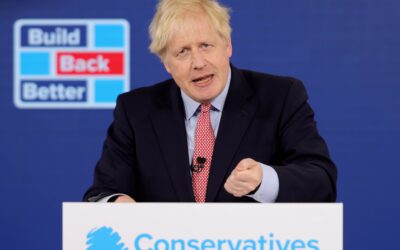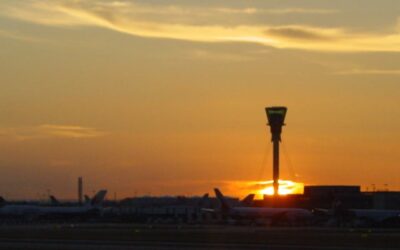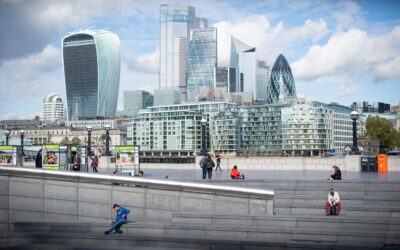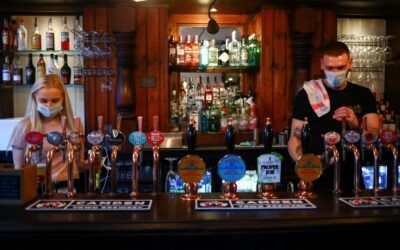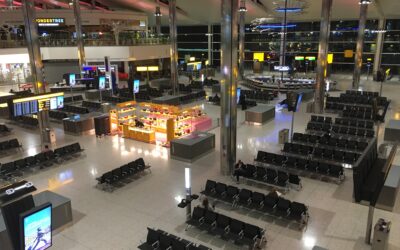They were built in the 20th century, making them ancient in aircraft terms. They have four thirsty engines rather than the twin jets of modern planes. But until the coronavirus pandemic struck, British Airways had planned to fly its venerable Boeing 747s for another four years.Today, though, the last two Jumbo jets in the colours of BA took off simultaneously from Heathrow on their final journeys. With the slump in intercontinental aviation, British Airways is retiring its final 747s early.To mark the event, the two remaining Jumbo jets at Heathrow airport were dispatched simultaneously from both the southern and northern runways.In normal times the prospect of such a display at the height of the morning rush would be unthinkable, but traffic at Heathrow and other UK airports has collapsed.Alex Cruz, chairman and chief executive of British Airways, paid tribute to “the incredible part they have played in our 100-year history and to the millions of customers and BA colleagues who have flown on board and taken care of them”.Read moreThe two aircraft, with registrations G-CIVB and G-CIVY, have flown 59 million and 45 million miles respectively.They are flying to Cardiff and to Kemble in Gloucestershire to be scrapped.They last flew commercially in April. A number of other British Airways 747s are in storage at Cardiff airport, while several more are in the California desert at Victorville.During its 49-year history with the airline, the Jumbo jet became known as the Queen of the Skies.According to the aviation analyst Cirium there are currently 492 Boeing 747s in service, in storage or on order. Thirty per cent are passenger aircraft, but of the 157 Jumbo jets in operation, just 35 are in service – with the remainder in storage. Only one in nine 747s in service is carrying passengers, with the remainder used for cargo.The 747 entered service with Pan Am in January 1970. It offered greater luxury for first-class passengers, and more seats in economy class, than ever before – two-and-a-half times the capacity of existing aircraft.Fares were cut to fill the increased number of seats, allowing average wage-earners to travel long-haul for the first time.BOAC – the long-haul predecessor of British Airways – was among the first carriers to order the plane, but due to a dispute with pilots they remained on the ground at Heathrow for around a year before entering commercial service. Cirium calculates that peak 747 was in July 1998, with 986 aircraft actively flown.The arrival of the Airbus A380 “SuperJumbo” in 2007 relegated the Jumbo to second-largest passenger plane. The European rival was bigger, quieter and more fuel efficient. But the 747 outsold it by six to one.How big is a 747?Length: 232 feet (71m). Wingspan: 211 feet (64m). Height: 69 feet (19.4m).How is it powered?Four engines (sometimes, if a spare is being flown, five). British Airways’ fleet was fitted with Rolls Royce RB211-524H engines.How fast?The maximum airspeed is 614mph (988km/h). Over the ground, the speed can be significantly higher with a tailwind. But the typical cruising speed is 565mph (910km/h). A 747-400 typically takes off at 180mph (290km/h) and lands at 160mph (260km/h).How far?The stated range of BA’s Jumbo fleet was 8,357 miles (13,450km), which was more than enough for the longest British Airways route, from London to Santiago in Chile.The longest regularly scheduled route was from Sydney to Dallas-Fort Worth, with Qantas. The distance is 8,578 miles (though the inbound flight, typically hampered by headwinds, had to land in Brisbane to refuel, as that was half-an-hour shorter).When did UK airlines start flying the plane?Jumbo jets were first flown by BOAC (long-haul predecessor to British Airways) on 14 April 1971. Virgin Atlantic began its life in June 1984 using a secondhand 747 to fly between Gatwick and New York Newark.How many passengers?That depends on the airline’s chosen configuration. The high-density 747s deployed on Japanese domestic routes carried up to 550 passengers. Virgin Atlantic had 455 seats on its Jumbo jets. But British Airways had no more than 345 seats on its 747s, and on some of the planes only 275; these were known as “Super High-J”, code because of the large number of Club World seats.During its lifetime, the world’s 747 fleet has flown almost four billion people – the equivalent of half the world’s population.
The Independent Articles
UK risks creating lost ‘Covid generation’ without extra support for young people, report warns
The UK risks creating a lost “Covid generation” unless additional support for training, housing and mental health is provided for young people, a report has warned.Adults aged 18 to 29 have endured an 80 per cent rise in mental health problems – more than any other age group – the Resolution Foundation found.Its analysis of the pandemic’s impact on different generations found young people and pensioners aged 65 to 79 have experienced the biggest deterioration in their employment situation.Over half of those aged 18-24 and 65+ who were employed before the pandemic have since stopped working – either by being furloughed or by losing their jobs altogether – compared to fewer than a third of those aged 30-50.
The Foundation warns that young and pension-age workers are most at risk during the next phase of the crisis, as furloughing ends and unemployment continues to rise. Read moreIf the Office for Budget Responsibility’s projection for unemployment to reach 11.9 per cent materialises, youth unemployment could rise to around 17 per cent – the same level as the early 1980s peak, according to the report.But while the jobs crisis has affected young and old alike, the report shows that the impact of the crisis on people’s living conditions has fallen most heavily on young people. Around one-in-seven people under the age of 30 have missed a rent or mortgage payment since the pandemic began, compared to just one-in-thirty 60-69s.”The growth of the high-cost, low-security private rental sector has led to missed housing payments and cramped living spaces during lockdown,” said David Willetts, president of the Resolution Foundation.
“It has also reinforced the underlying trends for younger people to have less wealth than young people did a generation ago, while increases in the value of houses and pensions particularly benefit older generations.”With infections rising again “the risk of losing a covid generation to long-term youth unemployment is real”, Willetts said. “But there is plenty that policy makers can do to prevent it – from extra training provision to a greater focus on creating new jobs to support people out of this crisis.”Alex Beer, welfare programme Head at the Nuffield Foundation said: “As the crisis continues, this research suggests that it is crucial for the government to not only support incomes, but to also take a broader approach to building resilience and improving living standards. Access to housing, skills training and mental health support will also be crucial for those most at risk of the adverse effects of the pandemic.”
We’re heading for a housing crash – and Boris Johnson just made it worse
Few television programmes can be as depressingly upbeat as Homes under the Hammer. It’s not the dated music, formulaic structure or the cheesy, lobotomised chirpiness of its presenters.It’s the fact that, every weekday morning, for 1,000 episodes now, it has nonchalantly exposed the glaring absurdity at the heart of UK economy, apparently without even realising.I’m not suggesting that a daytime TV show is responsible for the housing crisis. But Homes under the Hammer did start in 2003, which, coincidentally, was roughly when the UK property market finally ceased contact with objective reality, consigning a generation to insecure renting.
Government outlines plans to cut self-isolation
Four months after the aviation industry began calling for an alternative to quarantine, the government has said that a system to reduce the time spent in self-isolation by returning travellers will be introduced.A “Global Travel Taskforce” led by the transport secretary, Grant Shapps, and the health secretary, Matt Hancock, will decide on what form it will take by early November.At present arrivals to the UK from almost all countries must self-isolate under stringent conditions for two weeks. The quarantine rules have been called “a travel ban in all but name”.But the transport secretary, Grant Shapps, has concluded that passengers will be able to reduce the time spent in self-isolation by taking a single test – at their expense – and leave quarantine if it proves negative. It is yet to be decided whether that will be five, seven or eight days after arrival.Read more“Following agreement from medical experts, we are moving ahead with the next step to reduce the travel quarantine period by launching the Global Travel Taskforce to open up international travel & boost our businesses,” tweeted Mr Shapps.“The taskforce will implement a testing regime to reduce the self-isolation period, along with a wide range of other measures to enable travel whilst keeping #coronavirus rates down.”While a test after five days is predicted to be effective in only 85 per cent of cases, it will enable quarantine to be halved – which is expected to appeal to business travellers and some holidaymakers.The aviation industry, which has been extremely hard hit during the coronavirus pandemic, is desperate for a workable system to avoid two weeks of self-isolation in order to stimulate demand for Christmas and New Year flights – which are normally extremely profitable. A Virgin Atlantic spokesperson said, “Today’s announcement represents much needed progress, but every day counts when Britain’s economy and half a million jobs that rely on aviation are at stake.
“We support the government’s decision to opt for a single-test, private sector-led, passenger-funded approach that does not compete for, nor divert, vital NHS testing resources, to reduce travel restrictions while protecting public health.”But a firm commitment that a comprehensive testing regime will be implemented in November is required to boost consumer confidence, enable global travel and protect jobs.”Many countries allow single or multiple tests as an alternative to quarantine.Work is also in progress with officials in the US and Singapore aimed at setting up quarantine-free corridors, based on a yet-to-be-agreed testing protocol.The transport secretary’s announcement came on the day that the UK’s rate of new cases of coronavirus per 100,000 people reached 126, over six times the government’s own threshold for defining countries as “high risk” for Covid-19.Paul Charles, chief executive for The PC Agency and a campaigner for a “test and quarantine” programme to enable airlines and holiday companies to continue, said: “The intention to cut quarantine time by 50 per cent or more, with a single test, is welcome news.“It will create more confidence to book and safely travel knowing there is a shorter self-isolation time that won’t impact the NHS.”Heathrow airport and partners have been calling for a testing system since June. A facility is already installed at Heathrow, awaiting permission to go ahead.In the past week the government has faced a barrage of criticism over its current “double-lock” policy to impose quarantine and warn against all non-essential travel when a country’s coronavirus rates rise too high. The chief executive of Abta, Mark Tanzer, described it as “incoherent,” while Julia Lo Bue Said, chief executive of the Advantage Travel Partnership accused the government of “industrial sabotage”.At present the only major countries with no restrictions on travel in either direction to or from the UK are Italy and Sweden – both of which may be placed on the “no-go” list in the government’s next review of quarantine, due on Thursday 8 October.
Government outlines plans to cut self-isolation
Four months after the aviation industry began calling for an alternative to quarantine, the government has said that a system to reduce the time spent in self-isolation by returning travellers will be introduced.A “Global Travel Taskforce” led by the transport secretary, Grant Shapps, and the health secretary, Matt Hancock, will decide on what form it will take by early November.At present arrivals to the UK from almost all countries must self-isolate under stringent conditions for two weeks. The quarantine rules have been called “a travel ban in all but name”.But the transport secretary, Grant Shapps, has concluded that passengers will be able to reduce the time spent in self-isolation by taking a single test – at their expense – and leave quarantine if it proves negative. It is yet to be decided whether that will be five, seven or eight days after arrival.Read more“Following agreement from medical experts, we are moving ahead with the next step to reduce the travel quarantine period by launching the Global Travel Taskforce to open up international travel & boost our businesses,” tweeted Mr Shapps.“The taskforce will implement a testing regime to reduce the self-isolation period, along with a wide range of other measures to enable travel whilst keeping #coronavirus rates down.”While a test after five days is predicted to be effective in only 85 per cent of cases, it will enable quarantine to be halved – which is expected to appeal to business travellers and some holidaymakers.The aviation industry, which has been extremely hard hit during the coronavirus pandemic, is desperate for a workable system to avoid two weeks of self-isolation in order to stimulate demand for Christmas and New Year flights – which are normally extremely profitable. A Virgin Atlantic spokesperson said, “Today’s announcement represents much needed progress, but every day counts when Britain’s economy and half a million jobs that rely on aviation are at stake.
“We support the government’s decision to opt for a single-test, private sector-led, passenger-funded approach that does not compete for, nor divert, vital NHS testing resources, to reduce travel restrictions while protecting public health.”But a firm commitment that a comprehensive testing regime will be implemented in November is required to boost consumer confidence, enable global travel and protect jobs.”Many countries allow single or multiple tests as an alternative to quarantine.Work is also in progress with officials in the US and Singapore aimed at setting up quarantine-free corridors, based on a yet-to-be-agreed testing protocol.The transport secretary’s announcement came on the day that the UK’s rate of new cases of coronavirus per 100,000 people reached 126, over six times the government’s own threshold for defining countries as “high risk” for Covid-19.Paul Charles, chief executive for The PC Agency and a campaigner for a “test and quarantine” programme to enable airlines and holiday companies to continue, said: “The intention to cut quarantine time by 50 per cent or more, with a single test, is welcome news.“It will create more confidence to book and safely travel knowing there is a shorter self-isolation time that won’t impact the NHS.”Heathrow airport and partners have been calling for a testing system since June. A facility is already installed at Heathrow, awaiting permission to go ahead.In the past week the government has faced a barrage of criticism over its current “double-lock” policy to impose quarantine and warn against all non-essential travel when a country’s coronavirus rates rise too high. The chief executive of Abta, Mark Tanzer, described it as “incoherent,” while Julia Lo Bue Said, chief executive of the Advantage Travel Partnership accused the government of “industrial sabotage”.At present the only major countries with no restrictions on travel in either direction to or from the UK are Italy and Sweden – both of which may be placed on the “no-go” list in the government’s next review of quarantine, due on Thursday 8 October.
Taxpayers on the hook for billions of pounds of Covid loans made to criminals, report finds
Taxpayers may have to pay billions of pounds to underwrite loans made to criminals thanks to the poor design of the government’s bounce back loan scheme, a committee of MPs has warned.In a report published on Wednesday, the National Audit Office found that the scheme could cost taxpayers as much as £26bn to underwrite loans which small businesses cannot pay back after the coronavirus pandemic.From that “eye-watering” total, billions of pounds could have been handed by banks to fraudsters, said Meg Hillier, chair of the Public Accounts Committee.”The scheme’s hasty launch means criminals may have helped themselves to billions of pounds at the taxpayer’s expense,” Ms Hillier said.
“Sadly, many firms won’t be able to repay their loans and the banks will be quick to wash their hands of the problem.Watch more“The government estimates that up to 60 per cent of the loans could turn bad – this would be a truly eye-watering loss of public money.”Meanwhile, banks will collect fees and interest payments of up to 2.5 per cent per year on an estimated £43bn of lending.Campaign group Positive Money estimates that could mean hundreds of millions of pounds of profits for banks who have taken no risk because loans are 100 per cent guaranteed by the taxpayer. The NAO said the Treasury did not develop a business case for the scheme, which meant that it “lacked clear objectives” beyond the aim of fast financial support for smaller SMEs.
It was also left open to fraud because it relied fully on “self-certification” by borrowers, unlike the Swiss and German loan schemes it imitated, the NAO said.For the first four weeks of the scheme’s operation, there was no system in place to prevent businesses receiving loans with multiple lenders even though this was against the rules.It emerged last week that the boss of the state-owned British Business Bank, which oversees the scheme, raised concerns about its vulnerability to fraud. The National Crime Agency has also launched an investigation into organised criminals collecting bounce back loan money.
Watch moreRishi Sunak unveiled the bounce back scheme in May after the existing Coronaviris Business Interruption Loan Scheme (CBILS) failed to get money to small businesses who needed it.Firms found that high street lenders were refusing to lend to them under CBILS because the government only backed 80 per cent of the borrowing, leaving banks on the hook for some losses if they defaulted.Bounce back loans of up to £50,000 are available to businesses of any size with few checks carried out.
In his Winter Economic Plan unveiled last month, Mr Sunak extended the repayment period for bounce back loans to up to 10 years.
The true scale of taxpayer losses will not begin to become known until at least May next year when businesses must make their first repayments, the NAO said. Fran Boait, executive director of campaign group Positive Money, said the UK was walking into another “implicit bailout” of banks. “Far from simply helping small businesses to bounce back, the government’s loan schemes risk burdening them with unsustainable levels of debt, which many will struggle to repay,” she said.
“Unfortunately lending schemes have been designed to first and foremost protect the interests of banks, who are able to charge interest on loans which are fully guaranteed by the government, while shouldering the costs on the rest of us.
“The original Swiss programme the Bounce Back Loan Scheme was modelled on forbids lenders from charging any interest on such fully guaranteed loans. In the UK, lenders are able to charge interest rates of 2.5 per cent on these loans, which could mean banks receiving an income stream in the hundreds of millions of pounds without having to take on any risk.”
Far more than 500,000 pub, bar and restaurant jobs to go this year, hospitality boss warns
More than half a million pub, bar and restaurant workers will lose their jobs by the end of the year thanks to a 10pm curfew, local lockdowns and plunging consumer confidence, MPs have been warned.Kate Nicholls, boss of the trade body UKHospitality, told MPs that around 900,000 hospitality staff remain on full furlough payments with the government scheme set to end in a little over three weeks.UKHosptality had forecast 560,000 people in the industry would lose their jobs by the end of 2020 but Ms Nicholls said the figure is expected to be “far higher” after new restrictions were introduced in the last two weeks.She told the Commons Treasury Committee on Tuesday: “We are doing that data again but we anticipate it will be far higher due to local restrictions, the national constraints on events, working from home and the curfew,” she said.
The UK faces a cliff edge of unemployment at the end of the month, Ms Nicholls warned, as the furlough scheme which covers up to 60 per cent of an employee’s wages is replaced by the job support scheme which covers just 22 per cent.Read moreThe new scheme also has a built-in incentive for employers to sack staff rather than reducing their hours and keeping them on the payroll. Meanwhile, the 10pm curfew as well as fears about rising case numbers mean that trade for many bars and restaurants is less than half of normal levels, and as low as 20 to 30 per cent in city centres.”We fear that unless there are amendments for those areas which are particularly hit, you won’t avoid the cliff edge in October and we have got large numbers of redundancies that are forecast in October because of how the jobs support scheme is set up,” Ms Nicholls said.”There is a very real danger that we will lose large chunks of the economy – in hospitality we will have insolvent businesses, businesses going into administration and therefore that engine of growth for re-employing people will be lost for good.”I think that’s what we need to be focusing on to make sure we support viable jobs for the future. In our sector, those on full-time and part-time furlough are in viable jobs in the long term.”The government is under intense pressure to review both the curfew and the chancellor Rishi Sunak’s support measures amid growing fears they will condemn hundreds of thousands of people to joblessness, sucking spending out of the economy and deepening the impact of the pandemic. Hospitality, events and the arts are among the industries which are effectively banned from operating at full capacity by government decree, yet many businesses and workers are denied adequate financial support. Labour has demanded a review of the 10pm curfew while the owner of G-A-Y nightclub has launched a judicial review against the decision, claiming that it has no scientific basis and may in fact encourage the spread of Covid-19. Read moreRain Newton-Smith, chief economist at the CBI, was more positive about the chancellor’s winter economy plan, hailing his new jobs plan as a “lifeline”, but said sector-focused support could still be needed.”At this next phase of the crisis we did need to see an evolution of the support and the jobs support scheme will help to save hundreds of thousands of jobs,” she said.”But we may need to look at how that scheme is designed over the coming weeks if a crisis escalates.
“For some sectors and businesses, we might need additional support.”
Is Boris Johnson really planning to increase state investment spending – or is it just spin?
In his speech at the Conservative Party conference on Tuesday, Boris Johnson made the eye-catching claim that wind turbines will provide all the electricity used by UK households within a decade.“Wind farms to power every home,” was the Daily Mail’s headline, based on an overnight pre-briefing on the contents of the prime minister’s speech. Yet the only financial commitment actually in the speech with respect to achieving this green energy revolution by 2030 was £160m of government investment for port infrastructure to help manufacture and install wind turbines.
G-A-Y nightclub owner launches legal action against government over 10pm curfew
The owner of nightclub G-A-Y has launched legal action against the government over its failure to provide evidence justifying the 10pm curfew imposed two weeks ago.
Jeremy Joseph is seeking a judicial review of the controversial decision which has put the future of some late-night venues in doubt.Critics say that the curfew may actually increase the spread of coronavirus by causing large numbers of people to leave pubs, clubs and restaurants at the same time rather than more gradually over the course of each night.Mr Joseph argued that the curfew has damaged the hospitality sector and “makes absolutely no sense”. “It does the opposite of protecting people by pushing them onto the street at the same time. They are going from being safe inside venues with staggered closing times to unsafe on overcrowded streets and overloaded public transport.
Watch more“This government has failed to show why the 10pm curfew was put in place and has published no scientific evidence to substantiate its implementation.
“It seems to direct the blame for this action on the sector, consistently treating the nighttime economy as a scapegoat when, in fact, we have years of operational experience of keeping customers safe, and have spent substantial time and effort making sure our venues are Covid secure.
“Enough is enough.”
Michael Kill, chief of the Night Time Industries Association, backed Mr Joseph’s position and said the “curfew and further restrictions on the sector has had a catastrophic impact on business levels, resulting in thousands of businesses making the difficult decision to close the doors, or make staff redundant.”
A Department for Health and Social Care spokesperson said: “The latest data suggests a considerable rise in the infection rate following people socialising in hospitality venues serving alcohol in recent weeks, so we have taken immediate action to cut the transmission rate and save lives and will keep all measures under constant review.
“The 10pm closure allows people to continue to socialise while reducing the risk of failing to socially distance.”
Government to finally allow airport testing as industry fury grows
As the number of unrestricted international travel options for British holidaymakers shrinks towards zero, the government has indicated it may finally allow testing to reduce the length of quarantine for arrivals to the UK.Ministers have repeatedly said that a Covid-19 test on arrival would identify only 7 per cent of people with the virus, though that figure – based on a theoretical paper written in June – has been widely disputed.Dozens of countries are using testing either as an alternative to quarantine or as a means to reduce the time travellers spend in self-isolation.With pressure growing from the aviation industry, the transport secretary, Grant Shapps, and the health secretary, Matt Hancock, are expected in the next few days to outline a test-and-quarantine programme.On Saturday, Stephen Barclay, the chief secretary to the treasury, told the Conservative Party conference the government is looking at “what testing can we have at airports, and how does that interact with the quarantine rules?”. Read moreThe minister said that Germany, where passengers from high-risk countries are required to quarantine until a negative test result is processed, is being studied as a possible model.Heathrow has been calling for testing at airports for four months.A spokesperson for the UK’s biggest gateway said: “We look forward to seeing the detail in the coming days.“Heathrow already has testing infrastructure in place and a green light to use it would be a welcome boost to UK exporters and businesses across the country that rely on foreign trade and visitors.”Mr Shapps said in early July that some form of testing was being considered, and last month said the concept was under “active review”.One senior airline source told The Independent: “By the time anything actually gets done there may not be anything left of the UK aviation industry to save.”As coronavirus case rates in the UK surged way above most other nations, Germany placed the majority of the country in its “high-risk” category. Only travellers from the parts of England roughly south of the Humber and Mersey are exempt from quarantine.From the weekend, passengers arriving in the UK from Turkey and Poland must self-isolate for two weeks.Turkey was placed on the no-go list because of concerns about the reliability of its infection figures. Poland was added because it crossed the government’s threshold of case rates, even though new infections in the UK are about three times higher.Gatwick airport’s chief executive, Stewart Wingate, has joined the calls for urgent action to allow families to meet at Christmas.Writing for Business Travel News, he criticised the government’s approach to quarantine, saying: “The unpredictable and sudden nature of these announcements has a dramatic impact on consumer confidence and traffic levels. It also forces us to take difficult, but necessary decisions about resizing our businesses and cutting jobs. “The travel restrictions inflicting so much pain on the aviation industry are likely to continue for the foreseeable future. “Quarantine could be lifted for passengers travelling between high-risk countries within Europe if they receive negative test results up to 72 hours before departure.“A coordinated, risk-based approach could help save thousands of aviation jobs and we should do everything possible to have it in place in time for people to visit friends and family at Christmas.”He said it may take four or five years for passenger numbers at Gatwick – previously the busiest single-runway airport in the world – to recover.The Civil Aviation Authority has revealed that one in five holders of Air Transport Organisers’ Licences (Atols) that expired at the end of September have not been renewed.Of the the 1,261 licences that expired on 30 September, 995 have been renewed and an additional 90 are still in process.

